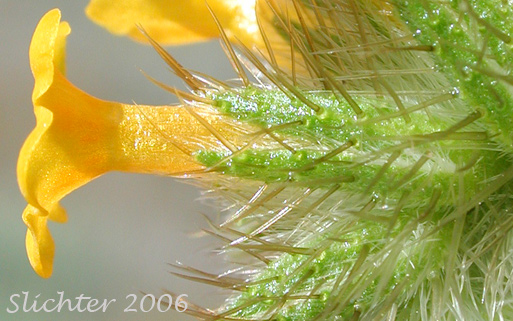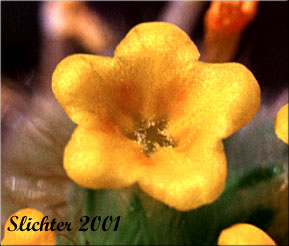 The
photo at right shows a close-up sideview of the flower of tarweed fiddleneck as
seen at Horsethief Butte, several miles northeast of The Dalles, OR...........April
24, 2006. Note the tube which extends several millimeters past the calyx and the
long spreading hairs covering the calyx lobes.
The
photo at right shows a close-up sideview of the flower of tarweed fiddleneck as
seen at Horsethief Butte, several miles northeast of The Dalles, OR...........April
24, 2006. Note the tube which extends several millimeters past the calyx and the
long spreading hairs covering the calyx lobes.
Tarweed fiddleneck is a somewhat weedy native species ith one or several simple or few-branched stems from 10-60 cm high. The stems are covered with long, spreading hairs and with shorter, softer hairs, which often are appressed to the stem and may point downward (retrorse). This latter characteristic could lead to confusion with rigid fiddleneck (A. retrorsa), but the latter species lacks hairs in the throat of the corolla.
The leaves are covered with stiff, mostly ascending hairs. The leaves are linear to linear-oblong in shape, with the upper leaves often lanceolate. The leaves are up to 10 cm long and to 1.5 cm wide, with many leaves crowded near the base of the plant.
The inflorescence is a scorpiod raceme or spike of yellow-orange flowers marked with vermilion in the throat. The raceme elongates as bloom proceeds. Individual flowers range from 7-9 mm long. The limb ranges from 3-6 mm wide with the throat obstructed by well-developed, hairy fornices (This last characteristic is a good diagnostic characteristic for identifying this species if a hand lense is available. The calyx is 6-10 mm long with free lobes of varying sizes and shapes.
Tarweed fiddleneck may often be found in disturbed soils on dry, open flats and slopes.
Tarweed fiddleneck may be found from southern British Columbia south along the east side of the Cascades to California and Nevada and east in the northern part of its range to western Montan. It may occasionally be found on the west side of the Cascades.
In the Columbia River Gorge, it may be found between the elevations of 100'-3000' from Mosier, OR east to the eastern end of the Gorge.
